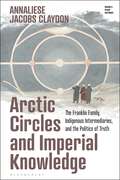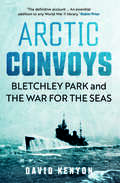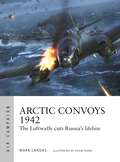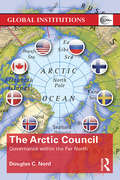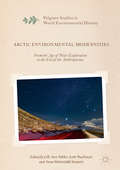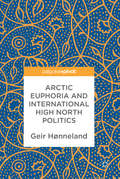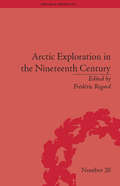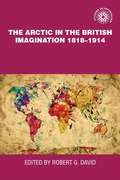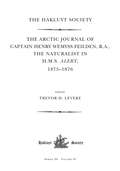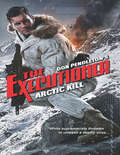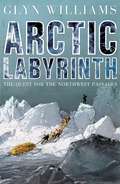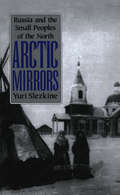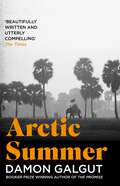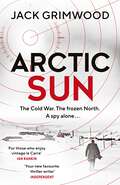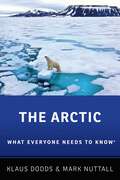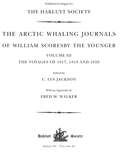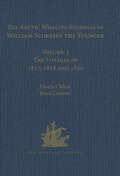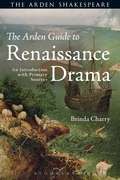- Table View
- List View
Arctic Circles and Imperial Knowledge: The Franklin Family, Indigenous Intermediaries, and the Politics of Truth (Empire’s Other Histories)
by Annaliese Jacobs ClaydonIn 1845 an expedition led by Sir John Franklin vanished in the Canadian Arctic. The enduring obsession with the Franklin mystery, and in particular Inuit information about its fate, is partly due to the ways in which information was circulated in these imperial spaces. This book examines how the Franklins and other explorer families engaged in science, exploration and the exchange of information in the early to mid-19th century. It follows the Franklins from the Arctic to Van Diemen's Land, charting how they worked with intermediaries, imperial humanitarians and scientists, and shows how they used these experiences to claim a moral right to information. Arctic Circles and Imperial Knowledge shows how the indigenous peoples, translators, fur traders, whalers, convicts and sailors who explorer families relied upon for information were both indispensable and inconvenient to the Franklins. It reveals a deep entanglement of polar expedition with British imperialism, and shows how geographical knowledge intertwined with convict policy, humanitarianism, genocide and authority. In these imperial spaces families such as the Franklins negotiated their tenuous authority over knowledge to engage with the politics of truth and question the credibility and trustworthiness of those they sought to silence.
Arctic Convoys: Bletchley Park and the War for the Seas
by David KenyonAn incisive account of the Arctic convoys, and the essential role Bletchley Park and Special Intelligence played in Allied success Between 1941 and 1945, more than eight hundred shiploads of supplies were delivered to the Soviet Union protected by allied naval forces. Each journey was a battle against the elements, with turbulent seas, extreme cold, and the constant dread of torpedoes. These Arctic convoys have been mythologized as defenseless vessels at the mercy of deadly U-boats—but was this really the case? David Kenyon explores the story of the war in the Arctic, revealing that the contest was more evenly balanced that previously thought. Battles included major ship engagements, aircraft carriers, and combat between surface ships. Amid this wide range of forces, Bletchley Park’s Naval Section played a decisive role in Arctic operations, with both sides relying heavily on Signals Intelligence to intercept and break each other’s codes. Kenyon presents a vivid picture of the Arctic theater of war, unearthing the full-scale campaign for naval supremacy in northern waters.
Arctic Convoys 1942: The Luftwaffe cuts Russia's lifeline (Air Campaign)
by Mark LardasA new history of the most crucial few months of the Arctic Convoys, when Germany's air power forced the Allies to retreat to the cover of winter. Between spring and autumn 1942, Germany was winning the battle of the Arctic Convoys. Half of PQ-15 was sunk in May, PQ-17 was virtually obliterated in July, and in September 30 percent of PQ-18 was sunk. The Allies were forced to suspend the convoys until December, when the long Arctic nights would shield them.Mark Lardas argues that in 1942, it was Luftwaffe air power that made the difference. With convoys sailing in endless daylight, German strike aircraft now equipped and trained for torpedo attacks, and bases in northern Norway available, the Luftwaffe could wreak havoc. Three-quarters of the losses of PQ-18 were due to air attacks. But in November, the Luftwaffe was redeployed south to challenge the Allied landings in North Africa, and the advantage was lost. Despite that, the Allies never again sailed an Arctic convoy in the summer months.Fully illustrated with archive photos, striking new artwork, maps and diagrams, this is the remarkable history of the Luftwaffe's last strategic victory of World War II.
Arctic Convoys 1942: The Luftwaffe cuts Russia's lifeline (Air Campaign)
by Mark LardasA new history of the most crucial few months of the Arctic Convoys, when Germany's air power forced the Allies to retreat to the cover of winter. Between spring and autumn 1942, Germany was winning the battle of the Arctic Convoys. Half of PQ-15 was sunk in May, PQ-17 was virtually obliterated in July, and in September 30 percent of PQ-18 was sunk. The Allies were forced to suspend the convoys until December, when the long Arctic nights would shield them.Mark Lardas argues that in 1942, it was Luftwaffe air power that made the difference. With convoys sailing in endless daylight, German strike aircraft now equipped and trained for torpedo attacks, and bases in northern Norway available, the Luftwaffe could wreak havoc. Three-quarters of the losses of PQ-18 were due to air attacks. But in November, the Luftwaffe was redeployed south to challenge the Allied landings in North Africa, and the advantage was lost. Despite that, the Allies never again sailed an Arctic convoy in the summer months.Fully illustrated with archive photos, striking new artwork, maps and diagrams, this is the remarkable history of the Luftwaffe's last strategic victory of World War II.
The Arctic Council: Governance within the Far North (Global Institutions)
by Douglas C. NordThis book helps us to think carefully about how this area of the world should be best handled in the future by offering a concise and accessible introduction to the Arctic Council. Over the past two decades, the Arctic has evolved from being a remote region in international affairs to becoming an increasingly central concern of the global community. The issues of climate change, access to new energy resources, the development of new global trade routes, the protection of the natural environment and the preservation of indigenous cultures and languages have all come to be focused within this formerly neglected region. Now in its nineteenth year of operation the Arctic Council, an innovative international organization, is going through a period of new growth and challenges. This work identifies the major trends and directions of current Arctic diplomacy and the manner in which national, regional and international leaders and organizations can all make useful contributions in dealing with the complex agenda of environmental, economic and political challenges faced by this increasingly significant area of the globe. This book will be of great interest to students and scholars of international organizations, international relations and the environment.
The Arctic Council: Governance within the Far North (Global Institutions)
by Douglas C. NordThis book helps us to think carefully about how this area of the world should be best handled in the future by offering a concise and accessible introduction to the Arctic Council. Over the past two decades, the Arctic has evolved from being a remote region in international affairs to becoming an increasingly central concern of the global community. The issues of climate change, access to new energy resources, the development of new global trade routes, the protection of the natural environment and the preservation of indigenous cultures and languages have all come to be focused within this formerly neglected region. Now in its nineteenth year of operation the Arctic Council, an innovative international organization, is going through a period of new growth and challenges. This work identifies the major trends and directions of current Arctic diplomacy and the manner in which national, regional and international leaders and organizations can all make useful contributions in dealing with the complex agenda of environmental, economic and political challenges faced by this increasingly significant area of the globe. This book will be of great interest to students and scholars of international organizations, international relations and the environment.
Arctic Environmental Modernities: From the Age of Polar Exploration to the Era of the Anthropocene (Palgrave Studies in World Environmental History)
by Lill-Ann Körber Scott MacKenzie Anna Westerståhl StenportThis book offers a diverse and groundbreaking account of the intersections between modernities and environments in the circumpolar global North, foregrounding the Arctic as a critical space of modernity, where the past, present, and future of the planet’s environmental and political systems are projected and imagined. Investigating the Arctic region as a privileged site of modernity, this book articulates the globally significant, but often overlooked, junctures between environmentalism and sustainability, indigenous epistemologies and scientific rhetoric, and decolonization strategies and governmentality. With international expertise made easily accessible, readers can observe and understand the rise and conflicted status of Arctic modernities, from the nineteenth century polar explorer era to the present day of anthropogenic climate change.
Arctic Euphoria and International High North Politics
by Geir HønnelandThis pivot describes the ups and downs of Norwegian High North politics since the end of the Cold War. It considers how political interest in the Arctic has been growing rapidly in the international community as states stake their claim to areas of the continental shelf in the Arctic Ocean, and focuses on Russia’s actions, as the Arctic state with the longest shoreline and the only one outside NATO. The author argues that among the Western countries, Norway has the most extensive experience in tackling Russia in the Arctic, and the neighbourhood with the Russian Bear invariably shapes foreign policy, notably in matters of security, and how foreign policy concerns are intertwined with economic motives, be that hopes of access to the big Russian market or to the oil and gas fields on the Russian Arctic shelf. To achieve the combined goal of security and business, the Norwegian Government has regularly orchestrated “Arctic waves” to direct the attention of local, national and international politicians and businesses to the alleged opportunities of the North. In this book, the author takes us through “the Great Barents Awakening” of the 1990s, “the Great High North Enchantment” of the early 2000s and recent years’ “Arctic wave” in Norwegian foreign policy.
Arctic Euphoria and International High North Politics
by Geir HønnelandThis pivot describes the ups and downs of Norwegian High North politics since the end of the Cold War. It considers how political interest in the Arctic has been growing rapidly in the international community as states stake their claim to areas of the continental shelf in the Arctic Ocean, and focuses on Russia’s actions, as the Arctic state with the longest shoreline and the only one outside NATO. The author argues that among the Western countries, Norway has the most extensive experience in tackling Russia in the Arctic, and the neighbourhood with the Russian Bear invariably shapes foreign policy, notably in matters of security, and how foreign policy concerns are intertwined with economic motives, be that hopes of access to the big Russian market or to the oil and gas fields on the Russian Arctic shelf. To achieve the combined goal of security and business, the Norwegian Government has regularly orchestrated “Arctic waves” to direct the attention of local, national and international politicians and businesses to the alleged opportunities of the North. In this book, the author takes us through “the Great Barents Awakening” of the 1990s, “the Great High North Enchantment” of the early 2000s and recent years’ “Arctic wave” in Norwegian foreign policy.
Arctic Exploration in the Nineteenth Century: Discovering the Northwest Passage (Empires in Perspective)
by Frédéric RegardFocusing on nineteenth-century attempts to locate the northwest passage, the essays in this volume present this quest as a central element of British culture.
Arctic Exploration in the Nineteenth Century: Discovering the Northwest Passage (Empires in Perspective)
by Frédéric RegardFocusing on nineteenth-century attempts to locate the northwest passage, the essays in this volume present this quest as a central element of British culture.
The Arctic in the British imagination 1818–1914 (Studies in Imperialism)
by Rob DavidThe Arctic region has been the subject of much popular writing. This book considers nineteenth-century representations of the Arctic, and draws upon an extensive range of evidence that will allow the 'widest connections' to emerge from a 'cross-disciplinary analysis' using different methodologies and subject matter. It positions the Arctic alongside more thoroughly investigated theatres of Victorian enterprise. In the nineteenth century, most images were in the form of paintings, travel narratives, lectures given by the explorers themselves and photographs. The book explores key themes in Arctic images which impacted on subsequent representations through text, painting and photography. For much of the nineteenth century, national and regional geographical societies promoted exploration, and rewarded heroic endeavor. The book discusses images of the Arctic which originated in the activities of the geographical societies. The Times provided very low-key reporting of Arctic expeditions, as evidenced by its coverage of the missions of Sir John Franklin and James Clark Ross. However, the illustrated weekly became one of the main sources of popular representations of the Arctic. The book looks at the exhibitions of Arctic peoples, Arctic exploration and Arctic fauna in Britain. Late nineteenth-century exhibitions which featured the Arctic were essentially nostalgic in tone. The Golliwogg's Polar Adventures, published in 1900, drew on adult representations of the Arctic and will have confirmed and reinforced children's perceptions of the region. Text books, board games and novels helped to keep the subject alive among the young.
The Arctic Journal of Captain Henry Wemyss Feilden, R. A., The Naturalist in H. M. S. Alert, 1875-1876 (Hakluyt Society, Third Series)
by Trevor LevereThe British Arctic Expedition of 1875–6 was the first major British naval expedition to the high Arctic where science was almost as important as geographical exploration. There were hopes that the expedition might find the hypothetical open polar sea and with it the longed-for Northwest Passage, and it did reach the highest northern latitude to date. The Royal Society compiled instructions for the expedition, and selected two full-time naturalists (an unusual naval concession to science), of whom one, Henry Wemyss Feilden, proved a worthy choice. Feilden was a soldier, who fought in most of the wars in his lifetime, including the American Civil War, on the Confederate side. On board HMS Alert, he kept a daily journal, a record important for its scientific content, but also as a view of the expedition as seen by a soldier, revealing admiration and appreciation for his naval colleagues; he performed whatever tasks were given to him, including the rescue of returning sledge parties stricken by scurvy. He also did a remarkably comprehensive job in mapping the geology of Smith Sound; some of his work, on the Cape Rawson Beds, was the most reliable until the 1950s. He was an all-round naturalist, and a particularly fine geologist and ornithologist. He was not just a collector; he pondered the significance of his findings within the context of the best modern science of his day: in zoology, Charles Darwin on evolution; in botany, Hooker on phytogeography, and in geology, Charles Lyell’s system. He illustrated his journal with his own sketches, and also enclosed the printed programmes of popular entertainments held on the ship, and verses for birthdays and sledging (there was a printing press onboard). The journal gives a vigorous impression of a ship’s company well occupied through the winter, then increasingly active in sledging and geographical discovery in spring, before the scurvy-induced decision to head home in the summer of 1876. After his return, Feilden had dealings with many scientists and their institutions, finding homes for and meaning in his collections.
The Arctic Journal of Captain Henry Wemyss Feilden, R. A., The Naturalist in H. M. S. Alert, 1875-1876 (Hakluyt Society, Third Series)
by Trevor H. LevereThe British Arctic Expedition of 1875–6 was the first major British naval expedition to the high Arctic where science was almost as important as geographical exploration. There were hopes that the expedition might find the hypothetical open polar sea and with it the longed-for Northwest Passage, and it did reach the highest northern latitude to date. The Royal Society compiled instructions for the expedition, and selected two full-time naturalists (an unusual naval concession to science), of whom one, Henry Wemyss Feilden, proved a worthy choice. Feilden was a soldier, who fought in most of the wars in his lifetime, including the American Civil War, on the Confederate side. On board HMS Alert, he kept a daily journal, a record important for its scientific content, but also as a view of the expedition as seen by a soldier, revealing admiration and appreciation for his naval colleagues; he performed whatever tasks were given to him, including the rescue of returning sledge parties stricken by scurvy. He also did a remarkably comprehensive job in mapping the geology of Smith Sound; some of his work, on the Cape Rawson Beds, was the most reliable until the 1950s. He was an all-round naturalist, and a particularly fine geologist and ornithologist. He was not just a collector; he pondered the significance of his findings within the context of the best modern science of his day: in zoology, Charles Darwin on evolution; in botany, Hooker on phytogeography, and in geology, Charles Lyell’s system. He illustrated his journal with his own sketches, and also enclosed the printed programmes of popular entertainments held on the ship, and verses for birthdays and sledging (there was a printing press onboard). The journal gives a vigorous impression of a ship’s company well occupied through the winter, then increasingly active in sledging and geographical discovery in spring, before the scurvy-induced decision to head home in the summer of 1876. After his return, Feilden had dealings with many scientists and their institutions, finding homes for and meaning in his collections.
Arctic Labyrinth: The Quest for the Northwest Passage
by Glyn WilliamsFor centuries British navigators dreamt of finding the Northwest Passage - the route over the top of North America that would open up the fabulous wealth of Asia to British merchants. We know now that, while several such passages exist, during the period of the search by sailing vessels they were choked by impassable ice. But this knowledge was slowly won, as expedition after expedition, under the most terrible conditions, slowly filled in their patchy and sometimes fatally misleading charts.Arctic Labyrinth tells this extraordinary story with great skill and brilliance. From the tiny, woefully equipped ships of the first Tudor expeditions to the icebreakers and nuclear submarines of the modern era, Glyn Williams describes how every form of ingenuity has been used to break through or try to get round the nightmarish ice barriers set in a maze of sterile islands. The heroism, folly and horror of these voyages seem almost unbelievable, with entire ships crushed, mass starvation, epics of endurance - and all in pursuit of a goal that ultimately proved futile.Williams's book is both an important work of exploration and naval history, and a remarkable study in human delusion and fortitude.
Arctic Mirrors: Russia and the Small Peoples of the North
by Yuri SlezkineFor over five hundred years the Russians wondered what kind of people their Arctic and sub-Arctic subjects were. "They have mouths between their shoulders and eyes in their chests," reported a fifteenth-century tale. "They rove around, live of their own free will, and beat the Russian people," complained a seventeenth-century Cossack. "Their actions are exceedingly rude. They do not take off their hats and do not bow to each other," huffed an eighteenth-century scholar. They are "children of nature" and "guardians of ecological balance," rhapsodized early nineteenth-century and late twentieth-century romantics. Even the Bolsheviks, who categorized the circumpolar foragers as "authentic proletarians," were repeatedly puzzled by the "peoples from the late Neolithic period who, by virtue of their extreme backwardness, cannot keep up either economically or culturally with the furious speed of the emerging socialist society."Whether described as brutes, aliens, or endangered indigenous populations, the so-called small peoples of the north have consistently remained a point of contrast for speculations on Russian identity and a convenient testing ground for policies and images that grew out of these speculations. In Arctic Mirrors, a vividly rendered history of circumpolar peoples in the Russian empire and the Russian mind, Yuri Slezkine offers the first in-depth interpretation of this relationship. No other book in any language links the history of a colonized non-Russian people to the full sweep of Russian intellectual and cultural history. Enhancing his account with vintage prints and photographs, Slezkine reenacts the procession of Russian fur traders, missionaries, tsarist bureaucrats, radical intellectuals, professional ethnographers, and commissars who struggled to reform and conceptualize this most "alien" of their subject populations.Slezkine reconstructs from a vast range of sources the successive official policies and prevailing attitudes toward the northern peoples, interweaving the resonant narratives of Russian and indigenous contemporaries with the extravagant images of popular Russian fiction. As he examines the many ironies and ambivalences involved in successive Russian attempts to overcome northern—and hence their own—otherness, Slezkine explores the wider issues of ethnic identity, cultural change, nationalist rhetoric, and not-so European colonialism.
Arctic Summer: Shortlisted for the 2015 Walter Scott Prize for Historical Fiction
by Damon GalgutShortlisted for the 2015 Walter Scott Prize for Historical FictionShortlisted for the 2015 Sunday Times Barry Ronge Fiction Prize Shortlisted for the 2015 University of Johannesburg English Literary Award Nominated for the 2014 Folio PrizeIn 1912, the SS Birmingham approaches India. On board is Morgan Forster, novelist and man of letters, who is embarking on a journey of discovery. As Morgan stands on deck, the promise of a strange new future begins to take shape before his eyes. The seeds of a story start to gather at the corner of his mind: a sense of impending menace, lust in close confines, under a hot, empty sky. It will be another twelve years, and a second time spent in India, before A Passage to India, E. M. Forster's great work of literature, is published. During these years, Morgan will come to a profound understanding of himself as a man, and of the infinite subtleties and complexity of human nature, bringing these great insights to bear in his remarkable novel.At once a fictional exploration of the life and times of one of Britain's finest novelists, his struggle to find a way of living and being, and a stunningly vivid evocation of the mysterious alchemy of the creative process, Arctic Summer is a literary masterpiece, by one of the finest writers of his generation.
Arctic Sun: The intense and atmospheric Cold War thriller from award-winning author of Moskva and Nightfall Berlin
by Jack GrimwoodTHE TIMES THRILLER OF THE MONTHFrom the award-winning author, of Moskva and Nightfall Berlin, comes this mesmerising suspense thriller.‘Strange alliances, personal vendettas and Cold War conspiracies build to a bloody climax in the snow’ - The Times Thriller of the MonthKola Peninsula, 1987. High in the Soviet Arctic, a tiny village houses an apocalyptic secret . . .When research zoologist Dr Amelia Blackburn ventures north to investigate the ravages of the Chernobyl reactor meltdown, she stumbles on the evidence of another sinister disaster on the Norway-Russia border - one that appears far from innocent. Mother Russia will stop at nothing to prevent this information from being revealed, putting Amelia and her team in grave danger from the moment they leave the site.When the news reaches London, the eyes of British intelligence turn to the one man with the knowledge and skills to bring her back to safety - and find out what has really happened in the frozen North.Major Tom Fox thought he'd put his intelligence career behind him, but wrapped in a custody battle for his young son, Charlie, a request from his high-ranking father-in-law forces his hand. When the reluctant spy reaches Russia, it quickly becomes clear that this is no ordinary mission.As Fox and Amelia fight for their lives - and their country - in Russia, Charlie is lead into dangers of his own in England. Three lives are about to be embroiled in the darkest secrets of the Cold War conflict - and a plot that, if left unchecked, will echo through history . . .Praise for Jack Grimwood'The new le Carré . . . an absolutely brilliant page-turner . . . if you love thrillers, Jack Grimwood is a name you need to remember' BBC Radio 2 The Sara Cox Show'For those who enjoy vintage le Carré' Ian Rankin'Mesmerising . . . something special in the arena of international thrillers' Financial Times'So atmospheric, so elegantly written ... I just disappeared into it totally' Marian Keyes'Your new favourite thriller writer' Independent'Top-notch ... the suspense never wavers' Crimetime'The rejuvenation of the espionage thriller continues apace' Guardian
ARCTIC WENK C: What Everyone Needs to Know® (What Everyone Needs To Know®)
by Klaus Dodds Mark NuttallConversations defining the Arctic region often provoke debate and controversy -- for scientists, this lies in the imprecise and imaginary line known as the Arctic Circle; for countries like Canada, Russia, the United States, and Denmark, such discussions are based in competition for land and resources; for indigenous communities, those discussions are also rooted in issues of rights. These shifting lines are only made murkier by the threat of global climate change. In the Arctic Ocean, the consequences of Earth's warming trend are most immediately observable in the multi-year and perennial ice that has begun to melt, which threatens ice-dependent microorganisms and, eventually, will disrupt all of Arctic life and raise sea levels globally. In The Arctic: What Everyone Needs to Know®, Klaus Dodds and Mark Nuttall offer concise answers to the myriad questions that arise when looking at the circumpolar North. They focus on its peoples, politics, environment, resource development, and conservation to provide critical information about how changes there can, and will, affect our entire globe and all of its inhabitants. Dodds and Nuttall explore how the Arctic's importance has grown over time, the region's role during the Cold War, indigenous communities and their history, and the past and future of the Arctic's governance, among other crucial topics.
The Arctic Whaling Journals of William Scoresby the Younger: Volume III: The voyages of 1817, 1818 and 1820 (Hakluyt Society, Third Series)
by William ScoresbyThis is the third and final volume in the set of William Scoresby's journals. It contains the unpublished accounts of his three voyages 1817, 1818 and 1820. During the years of the voyages in this volume Scoresby's life changed profoundly. An unsuccessful hunt for whales in 1817 led to a break with the Whitby shipowners, and command of the Fame in 1818 in partnership with his father. The partnership was a brief one, and at the end of 1818 Scoresby broke with his father and moved to Liverpool, finding new partners, completing the writing of An Account of the Arctic Regions and watching the construction of his new ship, the Baffin. Meanwhile he suffered a severe financial loss and made a profound religious commitment. After his first summer ashore for many years in 1819, he brought back to Liverpool in 1820 a 'full ship' of seventeen whales, despite being faced by mutineers in the crew who earlier had been involved in piracy in the Caribbean and, apparently, hoped to seize the Baffin 'and convey her and her valuable cargo to a foreign country'. In each of the journals, Scoresby wrote detailed descriptions of his landings: on Jan Mayen in 1817, western Spitsbergen in 1818, and the Langanes peninsula in northeast Iceland in 1820. The 1817 voyage, when Scoresby and others found the Greenland Sea relatively free of ice, involved him in the renewed British interest in arctic maritime exploration after the Napoleonic Wars. The Introduction to this volume contains a major reappraisal of Scoresby's role, especially in regard to his alleged mistreatment by John Barrow, Second Secretary of the Admiralty. The volume also contains an appendix by Fred M. Walker on the building of wooden whaleships such as the Baffin that were capable of routine ice navigation under sail as far north as 80°N, based on Scoresby's account, as Owners' Representative, at the beginning of the 1820 journal.
The Arctic Whaling Journals of William Scoresby the Younger: Volume III: The voyages of 1817, 1818 and 1820 (Hakluyt Society, Third Series)
by William ScoresbyThis is the third and final volume in the set of William Scoresby's journals. It contains the unpublished accounts of his three voyages 1817, 1818 and 1820. During the years of the voyages in this volume Scoresby's life changed profoundly. An unsuccessful hunt for whales in 1817 led to a break with the Whitby shipowners, and command of the Fame in 1818 in partnership with his father. The partnership was a brief one, and at the end of 1818 Scoresby broke with his father and moved to Liverpool, finding new partners, completing the writing of An Account of the Arctic Regions and watching the construction of his new ship, the Baffin. Meanwhile he suffered a severe financial loss and made a profound religious commitment. After his first summer ashore for many years in 1819, he brought back to Liverpool in 1820 a 'full ship' of seventeen whales, despite being faced by mutineers in the crew who earlier had been involved in piracy in the Caribbean and, apparently, hoped to seize the Baffin 'and convey her and her valuable cargo to a foreign country'. In each of the journals, Scoresby wrote detailed descriptions of his landings: on Jan Mayen in 1817, western Spitsbergen in 1818, and the Langanes peninsula in northeast Iceland in 1820. The 1817 voyage, when Scoresby and others found the Greenland Sea relatively free of ice, involved him in the renewed British interest in arctic maritime exploration after the Napoleonic Wars. The Introduction to this volume contains a major reappraisal of Scoresby's role, especially in regard to his alleged mistreatment by John Barrow, Second Secretary of the Admiralty. The volume also contains an appendix by Fred M. Walker on the building of wooden whaleships such as the Baffin that were capable of routine ice navigation under sail as far north as 80°N, based on Scoresby's account, as Owners' Representative, at the beginning of the 1820 journal.
The Arctic Whaling Journals of William Scoresby the Younger / Volume I / The Voyages of 1811, 1812 and 1813 (Hakluyt Society, Third Series)
by William ScoresbyWilliam Scoresby (1789-1857) made his first voyage in the whaler Resolution from Whitby to the Greenland Sea, west of Spitsbergen, in 1800. Three years later he was formally apprenticed to his father and another three years saw him promoted to chief officer. On 5 October 1810, his twenty-first birthday, ’the earliest at which, by reason of age, I could legally hold a command’, his father moved to Greenock and another ship, relinquishing the Resolution to his son. Another ten years would see the publication of what has been described as ’one of the most remarkable books in the English language’, his two-volume An Account of the Arctic Regions, with a History and Description of the Northern Whale-Fishery (1820). Even before he took command of the Resolution, two developments had occurred that, when combined with his seamanship and whaling skill, were to make that book ’the foundation stone of Arctic science’ and cause the journals of his annual voyages to be remarkable accounts in their own right. First, Scoresby had studied, during two brief winters at the University of Edinburgh. Teachers such as John Playfair and Robert Jameson had made him aware of the scientific importance of his arctic experience. Together with Sir Joseph Banks, the president of the Royal Society, they encouraged him to observe, experiment and record, and provided opportunities for his data to be published. Secondly, this encouragement, and the study habits he developed at Edinburgh, led Scoresby to expand the logs of his arctic voyages into lengthy journals that contained scientific records and social and religious comment as well as detailed descriptions of navigation and whaling.
The Arctic Whaling Journals of William Scoresby the Younger / Volume I / The Voyages of 1811, 1812 and 1813 (Hakluyt Society, Third Series)
by William ScoresbyWilliam Scoresby (1789-1857) made his first voyage in the whaler Resolution from Whitby to the Greenland Sea, west of Spitsbergen, in 1800. Three years later he was formally apprenticed to his father and another three years saw him promoted to chief officer. On 5 October 1810, his twenty-first birthday, ’the earliest at which, by reason of age, I could legally hold a command’, his father moved to Greenock and another ship, relinquishing the Resolution to his son. Another ten years would see the publication of what has been described as ’one of the most remarkable books in the English language’, his two-volume An Account of the Arctic Regions, with a History and Description of the Northern Whale-Fishery (1820). Even before he took command of the Resolution, two developments had occurred that, when combined with his seamanship and whaling skill, were to make that book ’the foundation stone of Arctic science’ and cause the journals of his annual voyages to be remarkable accounts in their own right. First, Scoresby had studied, during two brief winters at the University of Edinburgh. Teachers such as John Playfair and Robert Jameson had made him aware of the scientific importance of his arctic experience. Together with Sir Joseph Banks, the president of the Royal Society, they encouraged him to observe, experiment and record, and provided opportunities for his data to be published. Secondly, this encouragement, and the study habits he developed at Edinburgh, led Scoresby to expand the logs of his arctic voyages into lengthy journals that contained scientific records and social and religious comment as well as detailed descriptions of navigation and whaling.
The Arden Guide to Renaissance Drama: An Introduction with Primary Sources
by Brinda CharryThe Arden Guide to Renaissance Drama is a single critical and contextual resource for students embarking on an in-depth exploration of early modern drama, providing both critical insight and accessible contextual information. This companion equips students with the information needed to situate the plays in their socio-political, intellectual and literary contexts. Divided into two parts, it introduces students to the major authors and significant dramatic texts of the period and emphasises the importance of both a historicist and close-reading approach to better engage with these works.The Guide offers:· primary texts from key early modern scholars such as Machiavelli, Heywood and Sidney· contextual information vital to a full understanding of the drama of the period· close readings of 14 of the most widely studied play texts by Shakespeare and his contemporaries· a single resource to accompany any study of early modern dramaThis is an ideal companion for students of Renaissance drama, offering students and teachers a range of primary contextual sources to illuminate their understanding alongside close critical readings of the major plays of the period.
